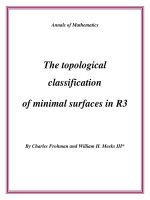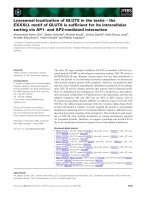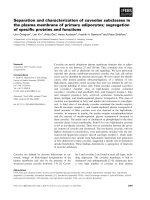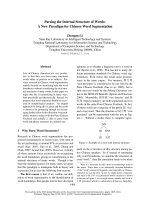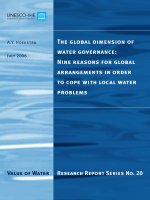The plasma chemistry of polymer surfaces advanced techniques for surface design
Bạn đang xem bản rút gọn của tài liệu. Xem và tải ngay bản đầy đủ của tài liệu tại đây (9.94 MB, 471 trang )
Jörg Friedrich
The Plasma Chemistry of
Polymer Surfaces
Related Titles
Parvulescu, V. I., Magureanu, M.,
Lukes, P. (eds.)
Plasma Chemistry and
Catalysis in Gases and Liquids
2012
ISBN: 978-3-527-33006-5
Schlüter, D. A., Hawker, C., Sakamoto,
J. (eds.)
Synthesis of Polymers
New Structures and Methods
Series: Materials Science and Technology
2 Volume Set
2012
ISBN: 978-3-527-32757-7
Knoll, W. Advincula, R. C. (eds.)
Functional Polymer Films
2 Volume Set
2011
ISBN: 978-3-527-32190-2
Rauscher, H., Perucca, M., Buyle, G. (eds.)
Plasma Technology for
Hyperfunctional Surfaces
Food, Biomedical, and Textile Applications
2010
ISBN: 978-3-527-32654-9
Hippler, R., Kersten, H., Schmidt, M.,
Schoenbach, K. H. (eds.)
Low Temperature Plasmas
Fundamentals, Technologies
and Techniques
2nd, revised and enlarged edition
2008
ISBN: 978-3-527-40673-9
Ostrikov, K.
Plasma Nanoscience
Basic Concepts and Applications of
Deterministic Nanofabrication
2008
ISBN: 978-3-527-40740-8
Harry, J. E.
Introduction to Plasma
Technology
Coqueret, X., Defoort, B. (eds.)
Science, Engineering and Applications
High Energy Crosslinking
Polymerization
2010
ISBN: 978-3-527-32763-8
Applications of Ionizing Radiation
2006
ISBN: 978-3-527-31838-4
Kawai, Y., Ikegami, H., Sato, N.,
Matsuda, A., Uchino, K., Kuzuya, M.,
Mizuno, A. (eds.)
Industrial Plasma Technology
Applications from Environmental to
Energy Technologies
2010
ISBN: 978-3-527-32544-3
Lazzari, M., Liu, G., Lecommandoux, S. (eds.)
Block Copolymers in
Nanoscience
2006
ISBN: 978-3-527-31309-9
Jörg Friedrich
The Plasma Chemistry of Polymer Surfaces
Advanced Techniques for Surface Design
The Author
Prof. Dr. Jörg Friedrich
BAM – Bundesanstalt für
Material forschung u. -prüfung
Unter den Eichen 87
12205 Berlin
All books published by Wiley-VCH are carefully
produced. Nevertheless, authors, editors, and
publisher do not warrant the information contained
in these books, including this book, to be free of
errors. Readers are advised to keep in mind that
statements, data, illustrations, procedural details or
other items may inadvertently be inaccurate.
Library of Congress Card No.: applied for
British Library Cataloguing-in-Publication Data
A catalogue record for this book is available from
the British Library.
Bibliographic information published by
the Deutsche Nationalbibliothek
The Deutsche Nationalbibliothek lists this
publication in the Deutsche Nationalbibliografie;
detailed bibliographic data are available on the
Internet at <>.
© 2012 Wiley-VCH Verlag & Co. KGaA, Boschstr.
12, 69469 Weinheim, Germany
All rights reserved (including those of translation
into other languages). No part of this book may be
reproduced in any form – by photoprinting,
microfilm, or any other means – nor transmitted or
translated into a machine language without written
permission from the publishers. Registered names,
trademarks, etc. used in this book, even when not
specifically marked as such, are not to be
considered unprotected by law.
Typesetting Toppan Best-set Premedia Limited,
Hong Kong
Printing and Binding Markono Print Media Pte Ltd,
Singapore
Cover Design Grafik-Design Schulz, Fußgönheim
Printed in Singapore
Printed on acid-free paper
Print ISBN: 978-3-527-31853-7
ePDF ISBN: 978-3-527-64803-0
oBook ISBN: 978-3-527-64800-9
ePub ISBN: 978-3-527-64802-3
mobi ISBN: 978-3-527-64801-6
V
Contents
Preface XI
1
Introduction 1
References 9
2
2.1
2.2
2.3
2.4
2.4.1
2.4.2
Interaction between Plasma and Polymers 11
Special Features of Polymers 11
Processes on Polymer Surfaces during Plasma Exposure 14
Influence of Polymer Type 23
Methods, Systematic, and Definitions 24
Surface Modification (Functionalization) 25
Coating of Polymer Surfaces with Functional Group-Bearing
Plasma Polymers 26
Plasma-Chemical Polymerization 26
Pulsed-Plasma Polymerization 27
Other Polymer Process 28
Polymer Etching 28
Crosslinking 29
Functional Groups and Their Interaction with
Other Solids 29
References 31
2.4.2.1
2.4.2.2
2.4.3
2.4.3.1
2.4.3.2
2.5
3
3.1
3.2
3.3
3.4
3.5
3.6
3.7
Plasma 35
Plasma State 35
Types of Low-Pressure Glow Discharges 45
Advantages and Disadvantages of Plasma Modification of Polymer
Surfaces 48
Energetic Situation in Low-Pressure Plasmas 49
Atmospheric and Thermal Plasmas for Polymer Processing 50
Polymer Characteristics 51
Chemically Active Species and Radiation 53
References 53
VI
Contents
4
4.1
4.2
4.3
Chemistry and Energetics in Classic and Plasma Processes 55
Introduction of Plasma Species onto Polymer Surfaces 55
Oxidation by Plasma Fluorination and by Chemical Fluorination
Comparison of Plasma Exposure, Ionizing Irradiation, and
Photo-oxidation of Polymers 65
References 67
5
5.1
5.1.1
5.1.2
5.2
5.2.1
5.2.2
5.2.3
5.2.4
5.2.5
5.2.6
5.2.7
5.2.8
Kinetics of Polymer Surface Modification 69
Polymer Surface Functionalization 69
Kinetics of Surface Functionalization 69
Unspecific Functionalizations by Gaseous Plasmas 72
Polymer Surface Oxidation 72
Polyolefins 72
Aliphatic Self-Assembled Monolayers 73
Polyethylene 75
Polypropylene 78
Polystyrene 79
Polycarbonate 85
Poly(ethylene terephthalate) 86
Summary of Changes at Polymer Surfaces on Exposure to Oxygen
Plasma 94
Categories of General Behavior of Polymers on Exposure to Oxygen
Plasma 97
Role of Contaminations at Polymer Surfaces 100
Dependence of Surface Energy on Oxygen Introduction 102
Polymer Surface Functionalization with Amino Groups 103
Ammonia Plasma Treatment for Introduction of
Amino Groups 103
Side Reactions 109
Instability Caused by Post-Plasma Oxidation 110
Exposure of Self-Assembled (SAM) and Langmuir–Blodgett (LB)
Monolayers to Ammonia Plasma 111
XPS Measurements of Elemental Compositions 112
ToF-SIMS Investigations 114
ATR-FTIR 115
CHN Analysis 117
NMR 118
Discussion of Hydrogenation and Amination of Polyolefins by
Ammonia Plasma 120
Carbon Dioxide Plasmas 123
SH-Forming Plasmas 126
Fluorinating Plasmas 126
Chlorination 134
Polymer Modification by Noble Gas Plasmas 136
References 139
5.2.9
5.2.10
5.2.11
5.3
5.3.1
5.3.2
5.3.3
5.3.4
5.3.5
5.3.6
5.3.7
5.3.8
5.3.9
5.3.10
5.4
5.5
5.6
5.7
5.8
64
Contents
6
6.1
6.2
6.3
6.4
6.5
6.6
6.7
6.8
6.9
6.10
6.11
6.12
6.13
6.14
7
7.1
7.2
7.2.1
7.2.2
7.2.3
7.2.4
7.3
7.4
7.5
7.6
7.7
7.8
7.9
8
8.1
8.2
8.3
Bulk, Ablative, and Side Reactions 145
Changes in Supermolecular Structure of Polymers 145
Polymer Etching 151
Changes in Surface Topology 155
Plasma Susceptibility of Polymer Building Blocks 158
Plasma UV Irradiation 160
Absorption of Radiation by Polymers 162
Formation of Unsaturations 165
Formation of Macrocycles 169
Polymer Degradation and Supermolecular Structure
of Polymers 171
Crosslinking versus Degradation of Molar Masses 175
Radicals and Auto-oxidation 177
Plasma-Induced Photo-oxidations of Polymers 181
Different Degradation Behavior of Polymers on Exposure to
Oxygen Plasma 181
Derivatization of Functional Groups for XPS 185
References 193
Metallization of Plasma-Modified Polymers 197
Background 197
Polymer Plasma Pretreatment for Well Adherent
Metal–Polymer Composites 198
Surface Cleaning by Plasma for Improving Adhesion 199
Oxidative Plasma Pretreatment of Polymers for Adhesion
Improvement 202
Reductive Plasma Pretreatment of Perfluorinated
Polymers 207
Adhesion Improvement Using Homo- and Copolymer
Interlayers 210
New Adhesion Concept 213
Redox Reactions along the Interface 220
Influence of Metal–Polymer Interactions on Interface-Neighbored
Polymer Interphases 224
Metal-Containing Plasma Polymers 227
Plasma-Initiated Deposition of Metal Layers 228
Inspection of Peeled Surfaces 228
Life Time of Plasma Activation 229
References 234
Accelerated Plasma-Aging of Polymers 239
Polymer Response to Long-Time Exposure to Plasmas
Hydrogen Plasma Exposure 244
Noble Gas Plasma Exposure, CASING 247
References 247
239
VII
VIII
Contents
9
9.1
9.2
9.3
9.3.1
9.3.2
9.3.3
9.4
9.4.1
9.4.2
9.4.3
9.4.4
9.4.5
9.4.6
9.4.7
9.4.8
9.4.9
9.4.10
9.5
9.5.1
9.5.2
9.5.3
9.5.4
9.5.5
9.5.6
9.5.7
9.6
9.7
9.7.1
9.7.2
9.7.3
9.7.4
9.7.5
10
10.1
10.2
10.3
Polymer Surface Modifications with Monosort Functional Groups 249
Various Ways of Producing Monosort Functional Groups at
Polyolefin Surfaces 249
Oxygen Plasma Exposure and Post-Plasma Chemical Treatment for
Producing OH Groups 251
Post-Plasma Chemical Grafting of Molecules, Oligomers, or
Polymers 256
Grafting onto OH Groups 256
Grafting onto NH2 Groups 257
Grafting onto COOH-Groups 258
Selective Plasma Bromination for Introduction of Monosort
C–Br Bonds to Polyolefin Surfaces 258
General Remarks 258
History of the Plasma Bromination Process 260
Theoretical Considerations on the Plasma Bromination Process 260
Bromination Using Bromoform or Bromine Plasmas 265
Bromination Using Allyl Bromide Plasma 269
Grafting onto Bromine Groups 271
Yield in Density of Grafted Molecules at Polyolefin Surfaces 272
Change of Surface Functionality 277
Surface Bromination of Polyolefins: Conclusions 279
Bromination of Poly(ethylene terephthalate) 280
Functionalization of Graphitic Surfaces 281
Bromination with Bromine Plasma 281
Dependence of Bromination Rate on Plasma Parameters 286
Alternative Plasma Bromination Precursors 287
Efficiency in Bromination of Carbon and
Polymer Materials 288
Grafting of Amines to Brominated Surfaces 288
Refunctionalization to OH Groups 289
NH2 Introduction onto Carbon Surfaces 289
SiOx Deposition 292
Grafting onto Radical Sites 294
Types of Produced Radicals 295
Grafting onto C-Radical Sites 295
Post-Plasma Quenching of Radicals 296
Grafting on Peroxide Radicals 296
Plasma Ashing 297
References 297
Atmospheric-Pressure Plasmas 303
General 303
Dielectric Barrier Discharge (DBD) Treatment 304
Polymerization by Introduction of Gases, Vapors, or Aerosols into a
DBD 311
Contents
10.4
10.5
10.6
10.6.1
10.6.2
10.6.3
10.6.4
10.6.5
11
11.1
11.2
11.3
11.3.1
11.3.2
11.3.3
11.4
11.5
11.6
11.7
11.8
11.9
11.10
11.11
11.12
11.13
11.14
12
12.1
12.2
12.3
12.4
12.5
12.6
12.7
12.8
Introduction of Polymer Molecules into the Atmospheric-Pressure
Plasma and Their Deposition as Thin Polymer Films
(Aerosol-DBD) 312
DBD Treatment of Polyolefin Surfaces for Improving Adhesion in
Metal–Polymer Composites 320
Electrospray Ionization (ESI) Technique 321
ESI + Plasma 327
ESI without Plasma 328
Comparison of Aerosol-DBD and Electrospray 329
Topography 330
Electrophoretic Effect of ESI 333
References 333
Plasma Polymerization 337
Historical 337
General Intention and Applications 340
Mechanism of Plasma Polymerization 341
Plasma-Induced Radical Chain-Growth Polymerization
Mechanism 342
Ion–Molecule Reactions 344
Fragmentation–(Poly)recombination (“Plasma Polymerization”) 344
Plasma Polymerization in Adsorption Layer or Gas Phase 345
Side-Reactions 346
Quasi-hydrogen Plasma 348
Kinetic Models Based on Ionic Mechanism 351
Kinetic Models of Plasma-Polymer Layer Deposition Based on a
Radical Mechanism 353
Dependence on Plasma Parameter 358
Structure of Plasma Polymers 361
Afterglow (Remote or Downstream) Plasmas 364
Powder Formation 366
Plasma Catalysis 367
Copolymerization in Continuous-Wave Plasma Mode 368
References 370
Pulsed-Plasma Polymerization 377
Introduction 377
Basics 377
Presented Work on Pulsed-Plasma Polymerization 381
Role of Monomers in Pulsed-Plasma Polymerization 382
Dark Reactions 384
Pressure-Pulsed Plasma 385
Differences between Radical and Pulsed-Plasma Polymerization 389
Surface Structure and Composition of Pulsed-Plasma Polymers 391
IX
X
Contents
12.9
12.10
12.10.1
12.10.2
12.10.3
12.10.4
12.11
12.12
12.12.1
12.12.2
12.12.3
12.12.4
12.12.5
12.12.6
12.13
12.14
Plasma-Polymer Aging and Elimination of Radicals in Plasma
Polymers 401
Functional Groups Carrying Plasma-Polymer Layers 403
Allyl Alcohol 403
Allylamine 413
Acrylic Acid 416
Acrylonitrile 421
Vacuum Ultraviolet (VUV) Induced Polymerization 422
Plasma-Initiated Copolymerization 424
Reasons for Copolymerization 424
Copolymer Kinetics 427
Allyl Alcohol Copolymers with Ethylene, Butadiene, and
Acetylene 427
Allyl Alcohol Copolymers with Styrene 434
Acrylic Acid 443
Copolymers with Allylamine 445
Graft Polymerization 447
Grafting onto Functional Groups 450
References 451
Index 457
XI
Preface
Some 40 years experience with plasmas applied to polymers and the special view
of a polymer chemist are the motivation for writing this book. The rapid growth
of applications of plasma processes on an industrial scale is connected with the
pioneering work of engineers. Basic research into plasmas and their properties is
associated with plasma and astrophysics. Pure plasmas of noble gases under welldefined conditions in exactly determined geometries are traditional objects of
plasma physics. Thus, chemical processes are out of view. However, in such
simple systems the chemistry of irradiation and release of degradation products
also play an important role, as do the polymer surface, near-surface layers, plasma
boundary layer, and plasma bulk. Organic and polymer chemistry often dominate
the use of molecular plasmas for polymer surface treatment and modification. A
much more complicated and complex situation is found for plasma polymerization processes, which can often be described only by formal kinetics as the elementary and chemical processes are not known in exact detail. Electrical low- and
atmospheric-pressure plasmas are characterized by a surplus in energy and
enthalpy needed for simple chemical processes. The chemistry of excess energy
allows endothermic reactions to be performed because the dose rate exceeds all
necessary enthalpies of reaction pathways known in chemistry or even in radiation
chemistry. Thus, random, statistic, and exotic processes dominate and, therefore,
the reaction products are most often chemically irregular in terms of structure and
composition. Additionally, the polymer products are unstable because of plasmaproduced metastable radicals that are trapped in the polymer bulk and which
subsequently remain capable of undergoing oxidation on exposure to oxygen from
air. Therefore, the plasma product is unstable and changes continuously during
storage. A nice example may illustrate such a “terrible” plasma. At the beginning
of my work, in the early 1970s, I had scraped plasma polymers from the wall of
the plasma reactor for infrared analysis. The plasma polymer flakes were collected,
cooled with liquid nitrogen, and then ground for production of polymer powder.
This powder was disseminated in KBr powder, which is necessary for KBr disk
preparation. After evaporation of nitrogen the sample begun to smolder and
became black. The technical assistant was stunned and did not want to continue
his work with other samples. The behavior of the sample was, in fact, due to the
fast reaction of radicals that came into contact with oxygen from the air after the
XII
Preface
plasma polymer layer was disintegrated. Peroxide formation and undefined autooxidation were initiated.
Organic chemists or polymer chemists turn away from such “black box chemistry,” labeling it as impure chemistry, far from regular chemistry, that does not
follow a defined chemical mechanism. Thus, the pure chemist is shocked and all
his knowledge is superfluous. If a polymer chemist must accept that chemically
inert gases, such as methane or benzene, can be polymerized or polymers exposed
to plasmas are destroyed, degraded, etched, and so on, any previous thinking, any
knowledge, is of no help.
The task of this book is to bring together physicists, engineers, chemists, and
polymer researchers, looking preferentially from the chemical and especially from
the polymer chemical point of view into plasma processes and the reactions in the
polymer body. Here, a new type of plasma chemist, who treats and produces polymers, is created or, better, a plasma polymer chemist is born.
Forty years of experience with plasma and polymer chemistry, analysis, and
polymer degradation have been concentrated in this book. It discusses important
findings in this field from all parts of the world.
Berlin, 20th September 2011
Jörg Friedrich
1
1
Introduction
The interaction of polymers with different materials such as metals, ceramics,
other polymers, coatings, or inorganics is crucial for the adhesion at interfaces in
polymer composite structural elements. The absence or weakness of interactions
as well as any lack of durability are responsible for the collapse of load-bearing
composite components. In 2005 the ice rink in Bad Reichenhall (Germany) collapsed, burying several people, because of adhesion failure (fatigue of the interface
bonds).
Many polymers, in particular polyolefins, such as polyethylene and polypropylene are chemically inert and cannot strongly interact with other materials. The
reason for this is the absence of polar and reactive functional groups in their
structure. Thus, interactions with other materials are poor and so too is adhesion.
Weak physical interactions only occur. J. D. van der Waals found their existence
in 1879 [1]. These forces are electrostatic, induced and permanent dipoles, dispersion interactions, and hydrogen bonds. They are very weak and operate over a
short range [2]. Polyolefins show only dispersion interactions among their own
molecules and, thus, they are often difficult to wet or bond because of the absence
of polar groups, which are able to promote interactions to the other material.
Dipole or induced-dipole interactions or even chemical bonds between polymer
and coating at the interface require the existence of functional groups.
Polar groups are often introduced by flaming [3] or plasma exposure [4]. Such
oxidations form various oxidized polar species at the polyolefin surface, which can
undergo the desired interactions to other materials. The introduction of chemical
bonds at the interface is more efficient because of the much higher binding energies [5]. To install such covalent bonds between polymers and coatings, most often
the production of monotype functional groups at the polyolefin surface is a necessary precondition. Such monosort functionalization is extraordinarily difficult.
New processes have been developed for its realization, that is, exposure of the
polyolefin surface to brominating plasma [6]. The C–Br groups could be converted
into amino, carboxyl, or hydroxyl groups or consumed by amines, alcohols, and
glycols [7]. The additional introduction of flexible, water-repellent, and metalbinding spacer molecules by grafting onto C–Br groups produced highly adhered
and durable polyolefin composites [8].
The Plasma Chemistry of Polymer Surfaces: Advanced Techniques for Surface Design, First Edition.
Jörg Friedrich.
© 2012 Wiley-VCH Verlag GmbH & Co. KGaA. Published 2012 by Wiley-VCH Verlag GmbH & Co. KGaA.
2
1 Introduction
In highly stressed polymer components for structural assemblies all forces are
applied to the interface and distributed to the interfacial bonds. Either a large
number of weak physical interactions or a smaller number of strong chemical
bonds is needed to withstand the disruption under mechanical load along the interface. However, in general, chemically and structurally, completely different materials need to be joined together. Polymers, in particular polyolefins, show very low
surface energy and metals or inorganics a much higher one. The difference
amounts to two orders of magnitude (original value for polymers 30–40 mN m−1 and
for metals 1000–3000 mN m−1), which is nearly the same difference in surface
energy as before polymer treatment (40–50 and 1000–3000 mN m−1) [9]. At the
molecular level, interactions are absent due to the chemical inertness of polyolefins.
Post-polymerization introduction of functional groups onto polyolefin surfaces
has a principal problem. The (radical) substitution of H by any functional group
is accompanied by C–C bond scissions of the polymer backbone because of equivalent (or lower) binding energies [10]. Thus, degradation occurs simultaneously,
although C–C bonds were partially shielded from attack. Nevertheless, such a
disruption of the polymer surface produces anchoring points for physical and
chemical interactions but also a weak boundary layer, which is mechanically,
chemically, and thermally unstable (low molecular weight oxidized material,
LMWOM) [11]. Moreover, polymers, metals, or inorganics have thermal expansion
coefficients that differ by two orders of magnitude. Therefore, the thus produced
mechanical stress is focused onto the monolayer of interactions along the interface. As mentioned before, spacer introduction can balance this mechanical stress
along the interface.
The surface modification of polyolefins must be also considered within the
framework of 100 Mio tons production of polyethylene and polypropylene per year
worldwide. Several technical applications demand a solution to the adhesion
problem. Mechanical interlocking, chemical roughening by etching, ion and electron beam modification, UV irradiation, UV-induced graft copolymerization, laser
beam or excimer lamp irradiation, 60Co irradiation, flaming, corona treatment, use
of adhesion promoters, glues, adhesives, etc. were successfully tested to modify
polyolefin surfaces for adhesion [2]. However, all these pretreatments produce a
broad variety of different functional groups.
As mentioned before, the formation of monotype functional groups followed by
spacer grafting can solve the problem of moderate adhesive bond strength and
durability. However, the great energy and enthalpy excess present in a plasma is
most often responsible for non-selective reactions and the formation of a broad
variety of products [12].
The dream of all plasma chemists is to achieve monosort functionalized polyolefin surfaces. The excess energy present in the plasma state [13] and the equivalency
of C–C and C–H dissociation energies make it difficult to realize this dream [10].
However, a few chemical reactions produce end-products that are also stable
towards plasma. Examples of such stable end-products are (i) in the case of bromination the electronic state of the neighboring noble gas (krypton) and (ii) silica-like
SiOx layers formed in the oxidation of Si compounds in an oxygen plasma [14].
1 Introduction
a)
b)
OH
OH
OH
COOH
C=O
O
apolar polymer surface
without functional groups
CHO
COOH
OH
polar polymer surface
with functional groups
Figure 1.1 Assumed structure of polyethylene at the surface without functional groups (a),
and after surface oxidation and introduction of oxygen-containing functional groups groups
(b) and the behavior after wetting with a drop of water.
This book presents several variants of such surface techniques with monotype
functional groups, such as chemical post-plasma reduction, pulse-pressure plasma
polymerization, underwater plasma and glow discharge electrolysis, and deposition of functionalized prepolymers and oligomers by aerosol plasma and electrospray [15].
Polyolefins have a semi-crystalline structure, which can be represented by the
model of “Fransenmicelle” as shown in Figure 1.1.
Amorphous regions are characterized by random localization of macromolecular chains, whereas crystalline regions show the parallel and close orientation of
the all-trans configuration of the chain with folded loops, thus forming the lamellae as present in polyethylene [16].
The concept of polymer functionalization by plasma exposure is to attach atoms
or fragments of the dissociated plasma gas as functional group by H substitution
at the polymer chain. Since there are there many different fragments and atoms
present in the plasma a broad variety of related functional groups is produced.
The formation of at least 12 oxygen-containing groups at the surface of poly(ethylene
terephthalate) has been shown after oxygen plasma exposure [17].
There is also an interrelation between plasma, polymer, surface charging,
surface cleaning, surface functionalization, etching, and emission of degradation
products as well as changing of plasma by the appearance of oxygen-containing
groups in the gas phase and so on (Figure 1.2).
The substrate, here the polymer, gives a specific response to plasma exposure.
Polymers react very sensitively to any exposure to plasmas. This is due to their
complex and supermolecular structure. Polymers have some common features
with living matter and therefore they are very sensitive, in almost the same
manner, towards particle or radiation exposure. Thus, special knowledge of
polymer chemistry, physics, and technology is necessary to understand the specific
3
4
1 Introduction
oxygenplasma
oxygen plasma
O
O2
OH
O2 O
O3
CO2 CO H2O
O3
O
COOH
C=O
OH
polymer
polymer
as received
surface functionalization
COOH
O
C=O
polymer
etching + changed plasma
composition and parameters
Figure 1.2 Changes in plasma phase upon polymer etching.
plasma
ions
electrons
+
VUV irradiation
n
-
+
neutrals
n
-
+
n
n
-
+
+
-
-
n
polymer
Figure 1.3 Plasma particle shower and vacuum UV (VUV) irradiation of polymer surfaces
during plasma exposure.
and complex behavior of polymer surfaces on plasma exposure. Starting from
plasma physics and taking simple atomic (noble) or molecule gas plasmas, which
are well-defined and well-characterized but, nevertheless, are associated with high
power consumption and high average electron energy the contradictoriness of flow
from plasma to polymer, thus the confrontation is perfect. A shower of highenergy particles and photons bombards the polymer surface. A result of this
bombardment is the formation of degraded or crosslinked products with the complete loss of original structure (Figure 1.3) [18].
As a matter of course, as a precondition, the plasma gas temperatures should
be near room temperature or, in the case of energy-rich hot plasmas, a very short
residence time in the plasma zone is mandatory. Low gas temperature is characteristic for low-pressure glow discharges, also known as non-isothermal plasmas
or colloquially as “cold” plasmas [19]. Figure 1.4 shows schematically the prototype
of such a plasma, namely, the low-pressure DC (direct current) glow discharge.
The volume between the two electrodes is filled with the uniform plasma of the
“positive column,” which is the most suitable place for polymer treatment.
1 Introduction
ion+
excited
ion+
e–
anode +
excited
e
–
ion+
e–
ion+
excited
cathode –
e–
electr. resist.
d.c. source
Figure 1.4 Principle of plasma formation: direct current (DC) discharge tube with electrons,
ions, and energy-rich neutrals as excited states.
recipient
electrode
monomer
plasma
sample
r.f
≈
pump
Figure 1.5 Example of a plasma reactor: a diode-like plasmatron that produces a low-pressure
plasma suitable for polymer surface modification.
This type of discharge is very seldom used today because of the permanent
danger of electrode contamination and coating, which influence the plasma characteristics. Capacitively or inductively coupled radio-frequency (rf) or microwave
(mw) generated plasmas are used more often. Figure 1.5 shows the often used
diode-like reactor type, which is the most important among the broad variety of
plasmatron constructions. It is an example for the production of low-pressure
plasmas, called diode-like or parallel-plate reactor. Normally, one electrode is mass
(asymmetric coupling).
In contrast, the plasma bombardment of polymer surfaces (cf. Figure 1.3) is an
efficient, easy, clean, comfortable, and fast way to create reactive centers at which
plasma gas fragments or atoms can stick as new functional groups. The processes
starts, again, with desorption and functionalization and is continued by modification of near-surface layers, etching at the surface, and photo-modification of farfrom surface layers considering an overlap of all processes. The surface
functionalization is limited to an O/C ratio of about 0.28; a steady-state process
between continuation of introduction of functional groups and polymer etching
is then established. The maximum density of functional groups at the outermost
polymer surface is completed after a few seconds, most often after only 2 s [20].
Limiting the plasma exposure to such short treatment protects the polymer surface
against undesired advanced degradation and formation of defects. Moreover,
5
6
1 Introduction
applying minimal energy also preserves the original polymer structure. Preservation of original polymer structure is always the best guarantee for maximum mechanical properties and chemical integrity.
Unfortunately, the average and, especially, the maximal energy level of plasma
particles and radiation, particularly that of electrons, is about an order of magnitude higher than that of the binding energies in polymers. Thus, plasma chemistry
in a low-pressure glow discharge is equivalent to chemistry with a high excess of
energy. This discrepancy is the most important hindrance to polymer modification
by the use of plasma. Moreover, the plasma energy is continuously delivered as
electrical current from a power plant and introduced into the plasma from the
electrical power supply. Therefore, the electrically produced plasma is effectively
an inexhaustible source of energy/enthalpy.
The list of binding energies for different chemical bonds (in kJ mol−1) at 100 kPa
and 298 K reflects the situation in polymers: HC≡CH (963), N≡N (950), H2C=CH2
(720), N=N (418), O=O (498), N–N (163), H3C–CH3 (368), H–C2H5 (410), H–CH3
(435), H–CCl3 (402), H–C6H5 (460), H–CH2OH (402), H–Cl (431), H–OCH3 (440),
H–N(CH3)2 (398), and C–O (358) (3–6 eV binding energy). These binding energies
match exactly the average energies in electrical glow discharges working at low
pressures in the range 100–103 Pa. Considering the high energy tail of the electron
energy distribution function in a gas plasma (Ekin = 3–>20 eV) these electrons have
enough energy to break all chemical bonds present in polymers (Section 4.1). It
must be also considered that all electrons slowed or stopped by inelastic collisions
with atoms or ions in the plasma are re-accelerated to high energies due to the
applied electrical field. Thus, as noted, the plasma appears as a source of (nearly)
unlimited enthalpy/energy flow.
On the other hand, plasma is a very easy tool with which to form reactive sites
as radicals or functional groups independent of the inertness of polymer. In each
case the plasma forms anchoring sites for further chemical reactions.
Atoms at the topmost layer of solid surfaces have generally unsaturated valences
towards the gas phase. These unsaturated binding forces are responsible for the
surface energy of solids. This surface energy determines wetting and gluing properties. In alkyl chains any significant dipole moment is absent; thus, polyolefins,
silicones, or perfluorinated polymers have very low surface energies, composed of
the dispersion component without an appreciable polar component. The introduction of functional groups forms dipoles at the surface and, thus, the polar component of the surface energy is increased strongly, as presented schematically in
Figure 1.6 on an atomic level.
Drost, McTaggart, and Venugopalan, illustrated several traditional atmospheric
and low-pressure glow discharge processes in industry [19, 21, 22]. Polyolefin or
polymer modifications by surface functionalization were performed in atmosphericpressure plasmas (corona, barrier, and glow discharges) [23] or low-pressure glow
discharges [4]. This is because of the non-isothermal (non-equilibrium, nt) character of such plasmas, which show low gas temperatures (“cold” plasma) [24].
Thus, both the atmospheric and low-pressure plasmas were generally suited for
any polymer pretreatment. Very fast and continuous corona or barrier discharge
1 Introduction
7
unsaturated (vacant) valencies
dipoles
surface
surface
interactio
ns
between
atoms
interactio
ns
between
atoms
polymer solid
polymer solid
polymer with polar groups
unmodified polymer
Figure 1.6
Schematics of polymer surfaces.
weak boundary layer
O2 plasma
polymer
COOH
COOH C=O O
OH
OH
COOH C=O O
OH
OH
polymer
glue
metal coating
metallizing
polymer
OH
glue
O
OH
polymer
peeling
polyolefin
C=O
peeling
polymer
plasma-functionalized and
surface degraded
metal coating
glue
COOH
COOH C=O O
OH
OH
polymer
low peel strength
plasma-treated polymer
coated with solid metal
layer
OH
C=O
O
OH
polymer
high peel strength
plasma-treated polymer
coated with a viscous
adhesive
Figure 1.7 Schematic representation of a polyethylene surface before and after plasma
treatment as well as after coating with a viscous adhesive.
treatments of polymer foils at atmospheric pressure are traditional plasma applications to polymers on an industrial scale [25, 26]. However, the field of applications
of this atmospheric plasmas enlarged slowly because the surface modification
could not be well-controlled, is afflicted with a few inhomogeneities, and degraded
material (LMWOM) is formed. More recently, the atmospheric-pressure glow
discharge (APGD) has compensated these disadvantages [27, 28]. The non-selective
surface functionalization accompanied by uncontrolled degradation need not be
accepted, as demonstrated by use of the newly developed atmospheric-pressure
8
1 Introduction
Surface modification
ideal modification
plasma
polymer
polymer
polymer surface functionalization
original polymer
functionalized polymer
too strong modification
intense plasma
polymer
original polymer
ox
surface functionalization
+ polymer degradation
functionalized polymer and
oxidized surface (LMWOM)
plasma polymer adhesion promoter
plasma polymer
intense plasma
polymer
original polymer
ox
ox
polymer
polymer
surface functionalization
+ polymer degradation
adhesion-promoting
interlayer
plasma etching
intense plasma
polymer
polymer
surface roughening
original polymer
rough surface for mechanical
indenting
Composite interface
covalent or physical bonding
polymer
metal
metal deposition
functionalized polymer
covalent/physical bonds to metal
atoms
metal
worse adhesion by WBL
ox
ox
ox
polymer
metal deposition
functionalized polymer and
oxidized surface (LMWOM)
ox
ox
weak boundary layer (WBL)
good adhesion in spite of WBL
ox
ox
polymer
ox
polymer
functionalized polymer and
oxidized surface (LMWOM)
ox
polymer
ox ox
ox
viscous coating
coating
polymer
weak boundary layer (WBL) is
diluted in the bulk of coating
Figure 1.8 Schematics of adhesion promotion in polymer composites using the plasma
technique.
plasma techniques, such as aerosol barrier discharge and electrospray ionization
(ESI) film deposition [15].
The improved new plasma pretreatments aim to favor the introduction of (most
advantageously: monosort) functional groups onto the surface to enhance the
interactions to coatings or biomolecules or to form anchoring points for further
References
graft synthesis. In addition, surface roughening, crosslinking of surface-near
polymer layers, polymer etching, polymer ashing, and so on are also being examined by the plastic and electronic industries and in medical techniques.
Considering the use of plasma for adhesion promotion in more detail, the more
ambitious improvement of metal adhesion to polymers demands the application
of low-pressure glow discharge plasmas. The polyfunctional O-containing groups
are rapidly produced on exposure to the oxygen low-pressure plasma. However,
polymer degradation products at the interface of a polymer–metal composite
hinder the adhesion by forming a “weak boundary layer” (WBL) [29] that originates
from the LMWOM. This “debris” hinders adhesion to solid-phase metal layers. In
contrast, liquid paints or glues can assimilate these loosely bonded fragments,
dissolve and distribute them in the liquid phase of the adhesive. Thus it does not
strongly hinder the adhesion between the coating and the polymer. Now, the
coating can interact directly with the non-degraded polymer surface (Figure 1.7).
Roughening and crosslinking as well as plasma-chemical deposition of a thin
adhesion-promoting interlayer are alternatives (Figure 1.8).
References
1 van der Waals, J.D. and Kohnstamm, P.
2
3
4
5
6
7
8
9
10
11
(1908) Lehrbuch der Thermodynamik: Teil
1, Johann-Ambrosius Barth Verlag.
Wu, S. (1982) Polymer Interface and
Adhesion, Marcel Dekker, New York,
Basel.
Kreidl, W.H. and Hartmann, F. (1955)
Plast. Technol., 1, 31.
Rossmann, K. (1956) J. Polym. Sci., 19,
141.
Endlich, W. (1998) Kleb- und Dichtstoffe,
Vulkan-Verlag, Essen.
Friedrich, J., Wettmarshausen, S., and
Hennecke, M. (2009) Surf. Coat. Technol.,
203, 3647–3655.
Friedrich, J., Mix, R., and
Wettmarshausen, S. (2008) J. Adhesion
Sci. Technol., 22, 1123.
Huajie, Y., Mix, R., and Friedrich, J.
(2011) J. Adhesion Sci. Technol., 25,
799–818.
Enzyklopädie, K. (1970) Atom-Struktur
der Materie, VEB Bibliographisches
Institut, Leipzig.
Fanghänel, E. (2004) Organikum, 22nd
edn, Wiley-VCH Verlag GmbH,
Weinheim.
Strobel, M., Corn, S., Lyons, C.S., Korba,
G.A., and Polym, J. (1987) J. Polym. Sci.,
A., 25, 1295.
12 Friedrich, J., Kühn, G., Mix, R., Fritz, A.,
13
14
15
16
17
18
19
20
and Schönhals, A. (2003) J. Adhesion Sci.
Technol., 17, 1591–1618.
Friedrich, J., Kühn, G., Mix, R., and
Unger, W. (2004) Plasma Process. Polym.,
1, 28–50.
(a) Wettmarshausen, S., Mittmann,
H.-U., Kühn, G., Hidde, G., and
Friedrich, J.F. (2007) Plasma Process.
Polym., 4, 832–839; (b) Vasile, M.J. and
Smolinsky G. (1972) J. Electrochem. Soc.
119, 451–455.
Friedrich, J.F., Mix, R., Schulze, R.-D.,
Meyer-Plath, A., Joshi, R., and
Wettmarshausen, S. (2008) Plasma
Process. Polym., 5, 407–423.
Wunderlich, B. (1976) Macromolecular
Physics, vol. 2, Academic Press, New York.
Friedrich, J., Loeschcke, I., Frommelt, H.,
Reiner, H.-D., Zimmermann, H., and
Lutgen, P. (1991) J. Polym. Degrad. Stabil.,
31, 97–119.
Friedrich, J., Gähde, J., Frommelt, H.,
and Wittrich, H. (1976) Faserforsch.
Textiltechn./Z. Polymerenforsch., 27,
604–608.
Drost, H. (1972) Plasma Chemistry,
Akademie-Verlag, Berlin.
Friedrich, J.F., Unger, W.E.S., Lippitz, A.,
Koprinarov, I., Weidner, S., Kühn, G.,
9
10
1 Introduction
21
22
23
24
and Vogel, L. (1998) Metallized Plastics
5 & 6: Fundamental and Applied Aspects (ed.
K.L. Mittal), VSP, Utrecht, pp. 271–293.
McTaggart, F.K. (1967) Plasma Chemistry
in Electrical Discharges, Elsevier,
Amsterdam.
Venugopalan, M. (1971) Reactions under
Plasma Conditions, John Wiley & Sons,
Inc., New York.
Kim, C.Y., Evans, U., and Goring, D.A.I.
(1971) J. Appl. Polym. Sci., 15, 1357.
Hertz, G. and Rompe, R. (1973)
Plasmaphysik, Akademie-Verlag, Berlin.
25 Owens, D.K. (1975) J. Appl. Polym. Sci.,
19, 265.
26 Owens, D.K. (1975) J. Appl. Polym. Sci.,
19, 3315.
27 Guimond, S., Radu, I., Czeremuszkin,
G., Carlsson, D.J., and Wertheimer, M.R.
(2002) Plasmas Polym., 7, 71.
28 Klages, C.-P. and Grishin, A. (2008)
Plasma Process. Polym., 5, 368–376.
29 Bikerman, J.J. (1972) Angew. Makromol.
Chem., 26, 177.
11
2
Interaction between Plasma and Polymers
2.1
Special Features of Polymers
The class of organic polymers is closely related to natural macromolecular products. Numerous natural polymers are produced by animals or plants. Thus, polymers are positioned in nature at the borderline between organic materials and
living species. This special position determines the properties and the sensitive
response of polymers to chemical and physical interactions. In contrast to ionic
(inorganic, ceramic, glass) or metallic materials polymers are not able to distribute
reaction energy over the bulk, especially if introduced precisely by physical or
chemical processes. Consequently, there are local energy-rich spots, characterized
by increased movement of polymer chains, side-chains, or groups in the solid and
by supply of excess energy in bond scissions followed by extensive chemical
reactions.
Natural polymers also exhibit in many cases very simple structures, such as
waxes, which are also extensively produced industrially by synthesis, such as the
polyolefin polymers. The performance of polymers is strongly determined by
several important parameters such as chemical composition, structure of monomer
unit, polymerization degree or chain length or molar mass, and its distribution,
tacticity, branching, crosslinking, supermolecular structure, crystallinity, stretch
orientation, and so on.
Often, beginning at the surface, an oxidative aging of polymers is observed as
part of natural weathering. It is characterized by the attachment of molecular
oxygen as oxygen-containing polar group onto radicals, which are formed mechanically, by irradiation or by plasma exposure. On a low energy level, chromophore
groups (defects) in the polymer are starting points for oxidation. Radiative processes are also often associated with the formation of unsaturation and crosslinking
in deeper layers of the polymer. Unsaturations are also chromophoric centers and
can also undergo slow oxidation on exposure to air. The radical-promoted oxidation is often self-accelerated by the auto-oxidation process (see below).
There is also a physical aging, which is important for surface modification.
Functional groups at the surface are not permanently fixed. They can slowly
move and diffuse from the topmost layer to the bulk. Moreover, complete polymer
The Plasma Chemistry of Polymer Surfaces: Advanced Techniques for Surface Design, First Edition.
Jörg Friedrich.
© 2012 Wiley-VCH Verlag GmbH & Co. KGaA. Published 2012 by Wiley-VCH Verlag GmbH & Co. KGaA.
12
2 Interaction between Plasma and Polymers
segments equipped with functional groups diffuse into the bulk. This mobility of
functional groups and macromolecule segments is called “surface dynamics” or
“hydrophobic recovery” [1–3]. The driving force is thermodynamics. The high
concentration of functional groups becomes adjusted to the zero concentration in
the bulk by diffusion [4]. Figure 2.1 shows schematically the slow diving that
occurs upon rotation around the C–C bond and the segmental movement from
the surface to the bulk.
While diffusion and balancing of concentration are one driving force, the interaction of polar groups at polymer surface with water or other polar media is the
counterpart. If air at the surface is replaced by water the polar group returns to
the surface and forms hydrogen bonds with water molecules (Figure 2.2) [2].
X
surface
surface
CH2 CH CH2
CH2 CH2 CH2 CH2
bulk
bulk
surface
surface
CH2 CH CH2
X
X
CH2 CH2
bulk
bulk
rotation around C-C bonds
CH2 CH2
X
segmental movements
"hydrophobic recovery"
Figure 2.1 Schematic of “hydrophobic recovery” and surface dynamics.
water drop
H2O
HO OH
OH
surface
air
OH
OH
bulk
surface dynamics
Figure 2.2 Surface dynamics caused by different environments.
2.1 Special Features of Polymers
The formation of interactions between polar groups and water and the respective
energetic profit overcompensates the dilution tendency [5]. More complicated is
the situation when functional groups are protonated, find counter ions, are rearranged, or even grafted – then their mobility is strongly changed [6]. The existence
or absence of functional groups at a polymer surface determines its “communication” with the environment and, thus, the adhesion properties.
Another important factor for the mechanical behavior of polymers is the molar
mass and its distribution. Changes in molar mass may provoke dramatic alterations
in mechanical properties of polymers. Polymers exposed to plasmas often show a
change of molar mass [7].
A general problem of any polyolefin surface modification is the equivalence of
C–C and C–H bond strengths. The binding energies (dissociation energies) of the
C–H- and C–C-bonds, which dominate the structure of polyolefins, are close
together as 435 kJ mol−1 for H–CH3, 411 kJ mol−1 for H–CH2–CH3, 396 kJ mol−1 for
(CH3)2CH–H, and 385 kJ mol−1 for (CH3)3C–H. The corresponding C–C bond has
similar (standard) dissociation energy, for example, 370 kJ mol−1 for CH3–CH3 (ca.
3 eV). In addition, these C–H- and C–C-binding energies vary strongly with the
type of substitution or residues and, thus, the ranges of binding energies overlap
widely. Therefore, specific chemical attack of the C–H bond in alkyl chains (polyethylene) is not possible and selective reactions are impossible. Consequently, only
the simultaneous attack of all C–H and C–C bonds occurs. This undesired behavior is supported by exothermic substitution reactions, which produce additional
thermally-initiated chain scissions. Nevertheless, surprisingly, in practice the
shielding of hydrogen atoms hinders slightly the preferred C–C bond scission and,
thus, degradation does not dominate too strongly [8].
The (standard) reaction enthalpy (R) of the radical H substitution reaction (SR)
by a plasma-formed functional group producing an atom or radical is given as
the difference of (standard) heats of formation (B) of the end product (E) and
starting material (S): ΔRH0 = ΔBH0E − ΔBH0S. Considering Hess rule ΔRH0 is the
difference of dissociation enthalpies of the scissioned (S) and formed (F) bonds:
ΔRH0 = ΣsΔDH0 − ΣFΔDH0. Therefore, for a raw estimation, the heat of formations
can be replaced by dissociation enthalpies [8]. Because of the gas–solid type of
reaction the entropy must be considered (Gibbs–Helmholtz): ΔRG0 = ΔRH0 − TΔRS0.
The entropy term ΔRS0 often shows ambivalent behavior [9]. This term is not
important if the number of products and educts are equal, phase transitions not
possible, and so on.
Oxidation and fluorination show strong exothermic character during the substitution reaction and, therefore, the reaction proceeds as an auto-oxidative process,
as demonstrated for fluorination:
F• + H − CH2 − CH3 → F −H + •CH2 − CH3
•
CH2 − CH3 + F2 → F − CH2 − CH3 + F•
Δ RH 0 = Δ DH 0CH3− CH2 − H − Δ BH 0H − F = 411 − 566 kJ mol −1 = −155 kJ mol −1
13

